AMD's Pre-CES Haul: 12nm Ryzen CPUs, 7nm GPUs, 2000 Series Processors, X470 Chipset
LAS VEGAS, NV -- AMD announced new second-generation 12nm Ryzen processors, Desktop APU lineup, a 7nm GPU, and the expansion of the Ryzen mobile family.
AMD's busy 2018 comes on the heels of an incredibly disruptive 2017 that marked the return of competition to the desktop PC processor market. The company rolled through an amazing number of launches in 2017, including: the Ryzen 7, Ryzen 5, and Ryzen 3 series; Ryzen Pro; Ryzen Mobile; the Radeon RX Vega and 500 series; the new Xbox One X SoC; EPYC single socket and dual socket platforms; and Radeon Instinct. AMD may not match that intense cadence of 2018 product releases, but it has plenty of new items on the menu in 2018.
Su said the company is focusing on continuing to develop products that offer more performance at every price point up and down the stack. AMD will focus on new releases in all three of its core segments: PCs, Graphics, and Technology. That includes faster Ryzen and Threadripper models this year that wield a new 12nm process, along with two new desktop APUs and Ryzen Mobile PRO products.
Second Generation 12nm Ryzen & Threadripper Processors: Zen+ Makes An Entrance
AMD announced earlier this year at Global Foundries' Technology Conference that it's moving to a 12nm LP FinFET process for all of its client CPUs and GPUs. Now we know that AMD's next-generation Zen+ processors will arrive in April 2018. The company is already heavily sampling the new Zen+ models to its motherboard and PC partners.


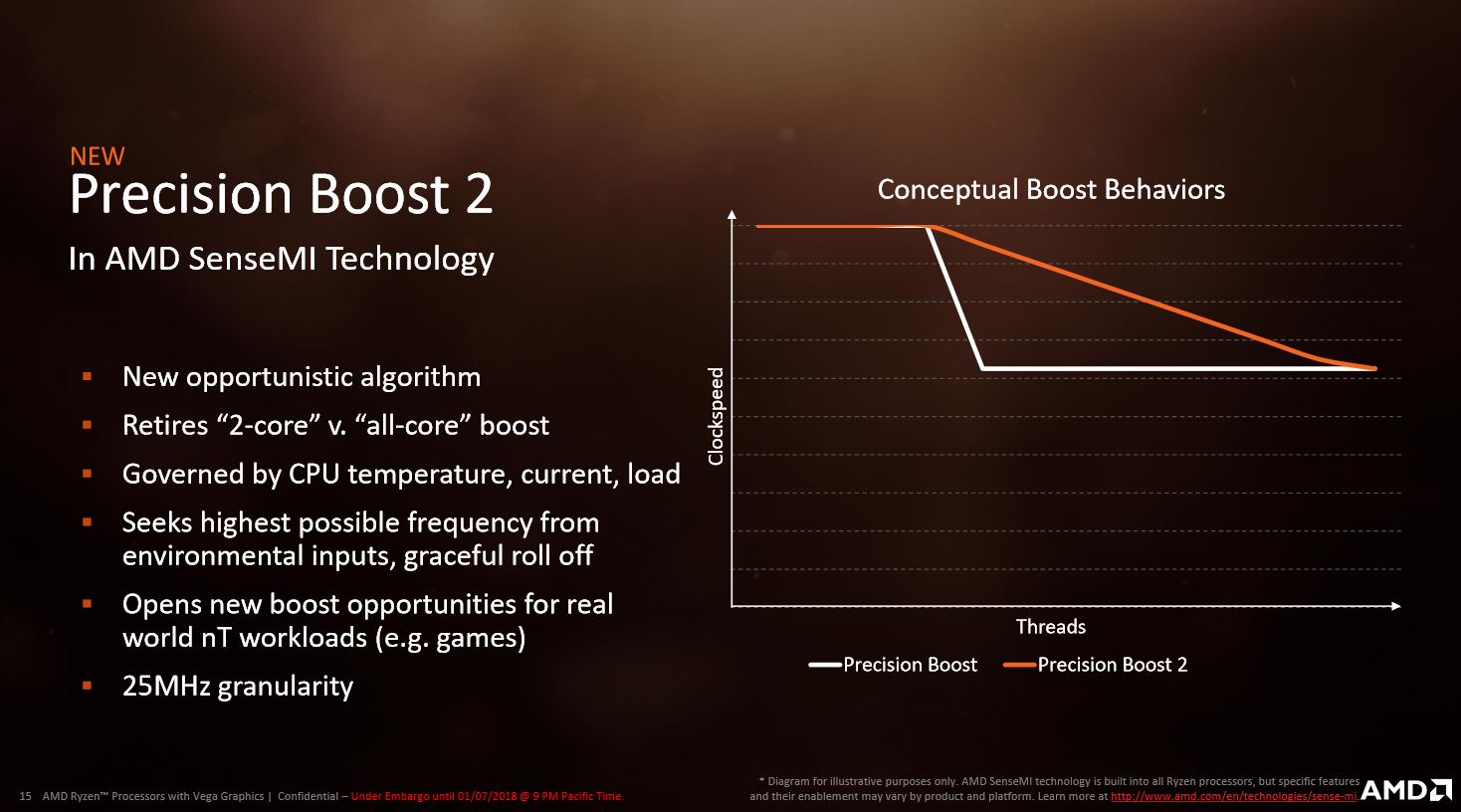

The new Zen+ models will span both the Ryzen 7, 5, and 3 families and also extend up to the high end desktop Threadripper models. AMD didn't answer detailed questions about the new process, but we do know that it will be a shrink (a "tick" equivalent if you will). The improved process will boost performance, but multiple variables will impact how much of the 10% in transistor-level performance gains translate directly to frequency/performance improvements. We do know the new process will provide more performance and reduce AMD's manufacturing expenses.
The company could also make other minor performance enhancements. For instance, the Threadripper processors feature lower L2 and L3 latency than the mainstream Ryzen models, even though they employ the same basic Zeppelin die building blocks. That means AMD has likely made several adjustments that may worm their way into the 12nm LP models.
The company did share an example of one of the new features. AMD announced that it's offering Precision Boost 2 Technology with its new Zen+ processors. AMD's Precision Boost feature, which debuted with the Ryzen desktop models, is similar to Intel's Turbo Boost. AMD's current-gen Ryzen processors provide only dual-core and all-core boost frequencies.
Get Tom's Hardware's best news and in-depth reviews, straight to your inbox.
AMD's new Precision Boost 2 algorithms include a more sophisticated set of boost frequencies that operate based on varying numbers of active threads. The feature now scales from one to eight active threads, which will help capitalize on Ryzen's already strong multi-threaded performance. AMD has not provided a complete listing of the frequencies yet.
Intel's 10nm process is notably late, and we don't expect it to make its way to the desktop until the second half of 2018, if not later. That gives AMD a big window to transition to 12nm LP. Even after the arrival of Coffee Lake, AMD's processors are still competitive, particularly in multi-threaded workloads. Boosting the frequency will help address one of Ryzen's few challenges, and improvements to the maximum overclock ceiling would be icing on the cake.



AMD also has a strong roadmap in place that includes the Zen 2 design based on the Global Foundries 7nm process. The Zen 2 design is already complete and is due in 2019. AMD didn't share any more details on the forthcoming microarchitecture, but the company also has a Zen 3 processor due in 2020 that's built on a 7nm+ process. This indicates that AMD is settling into a tick-tock-esque cadence, much like Intel used to.
Su also presented a slide that shows the IPC enhancements the company expects in the future. Matching Zen's original 52% gen-on-gen IPC uplift isn't a realistic goal for future revisions that enhance an already-strong architecture, but Su expects the company will deliver 7-8% more IPC throughput with each successive generation of products.




AMD surprisingly announced that it's launching a new 7nm GPU. AMD didn't provide many details, but we do know that the GPU, which will pave the way as AMD's first 7nm product, uses Global Foundries' process for a Radeon Instinct MI25 that features the Vega architecture. It's logical that the Radeon MI25, which AMD designed primarily for machine learning workloads, will pave the way for future AMD GPUs and CPUs on the 7nm process.
AMD's decision to move to the 7nm process in 2018 with GPUs, as opposed to transitioning in 2019 like it is with CPUs, is a smart move. GPUs have large die with many redundant elements that AMD can disable in the event of a defect. Naturally, the company will likely encounter more defects early in the 7nm lifespan, so a large GPU die with many redundancies is a good place to begin development. AMD can simply overprovision some elements and disable them for defect avoidance purposes, which helps boost yields. Of course, irreparable defects that fall into a more critical area of the chip, such as I/O interconnects or critical pathways, often scuttle chips.
AMD also announced that it's developing Radeon Vega Mobile GPUs. These premium mobile GPUs will address a segment of the market that Nvidia now largely owns, so it could represent a significant growth opportunity for AMD. Navi will also follow on the 7nm process in 2019. Navi will also follow on the 7nm process in 2019. Again, details were slight, but we expect the company to provide more information over the coming months.
AMD 2000-Series Desktop APUs
| Row 0 - Cell 0 | Ryzen 5 2400G With Radeon RX Vega Graphics | Ryzen 3 2200G With Radeon Vega Graphics |
| Cores Threads | 4/8 | 4 / 4 |
| Max Boost Clock (GHz) | 3.9 | 3.7 |
| Graphics Compute Units | 11 | 8 |
| Max GPU Clock (MHz) | 1250 | 1100 |
| L2/L3 Cache (MB) | 6 | 6 |
| cTDP (Watts) | 45-65W | 45-65W |
| Price | $169 | $99 |
AMD is also introducing its new lineup of 2000-Series Desktop APUs. These new models feature many of the same architectural characteristics of their Ryzen Mobile counterparts. The 4C/8T Ryzen 5 2400G comes with a much higher 45-65W TDP ceiling that enables boost clocks up to 3.9 GHz. The Ryen 5 2400G also features 11 Vega Compute Units (CU) that boost up to 1250 MHz. Both chips come with 6MB of L3 cache, but the Ryzen 3 2200G model steps back to eight CUs that boost to 1100 MHz. The Ryzen 3 2200G steps back to a 3.7 GHz boost clock. AMD hasn't shared base frequencies yet.








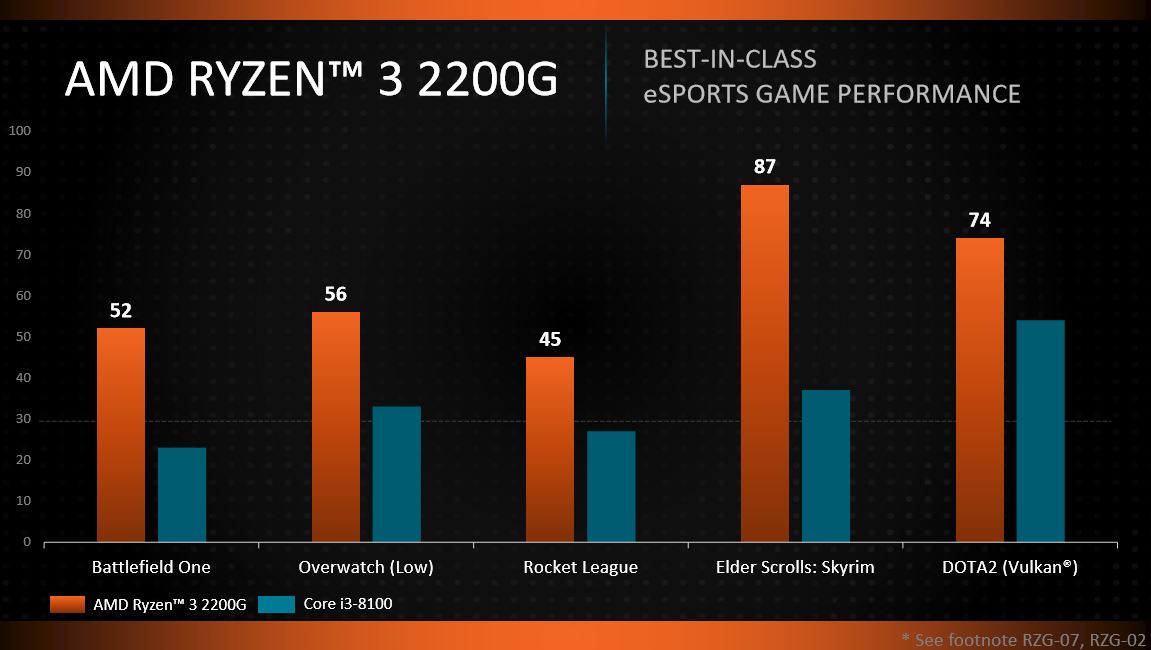

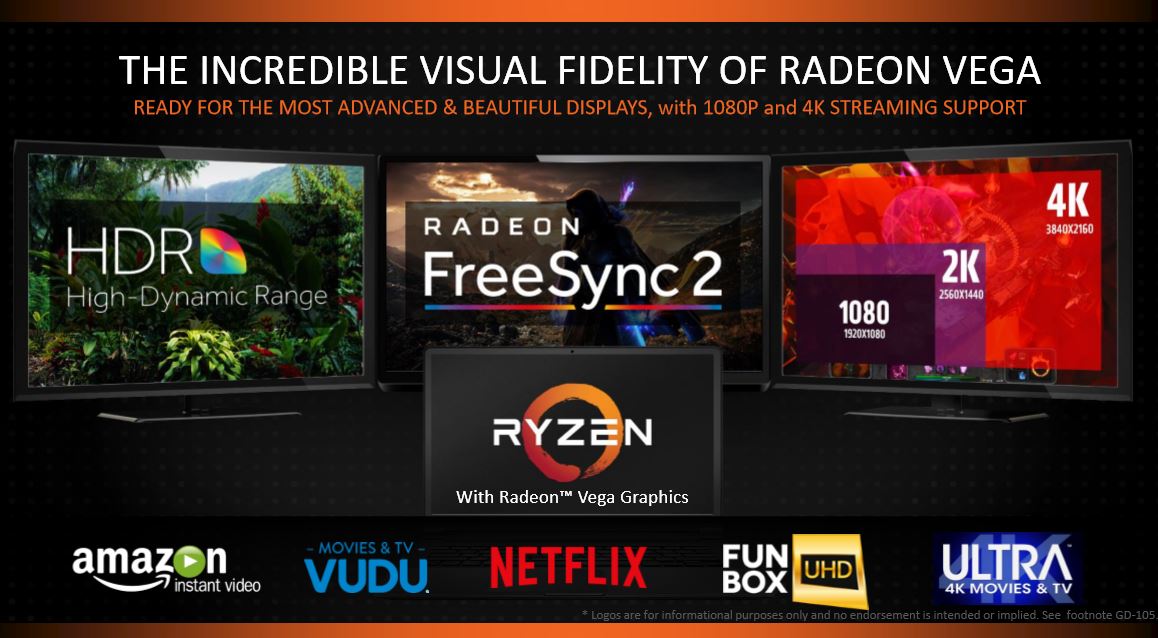
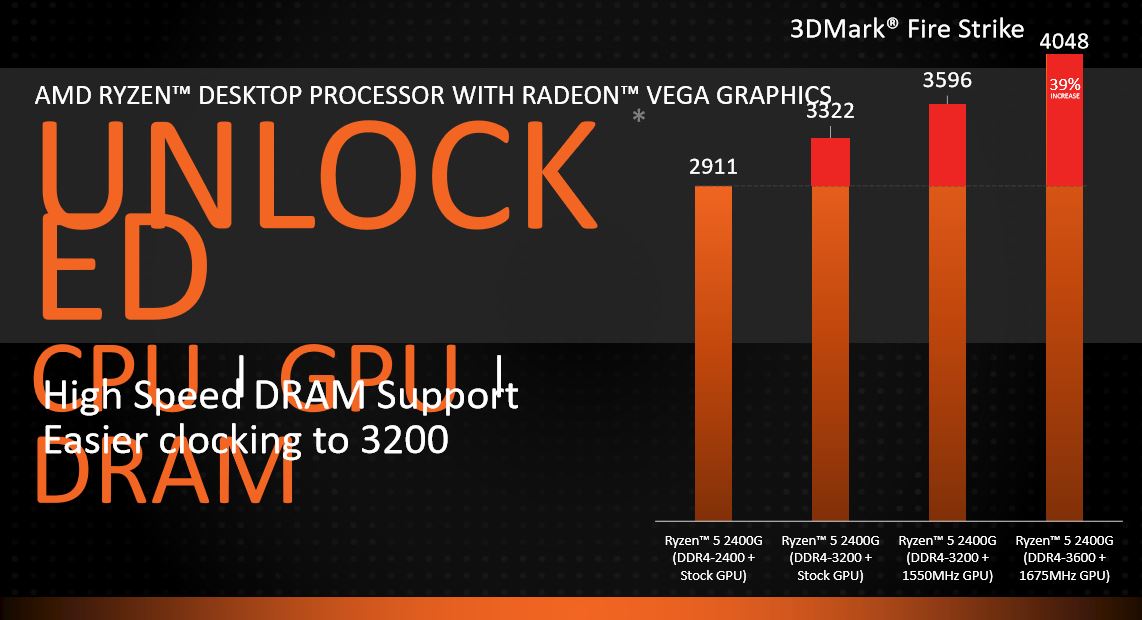
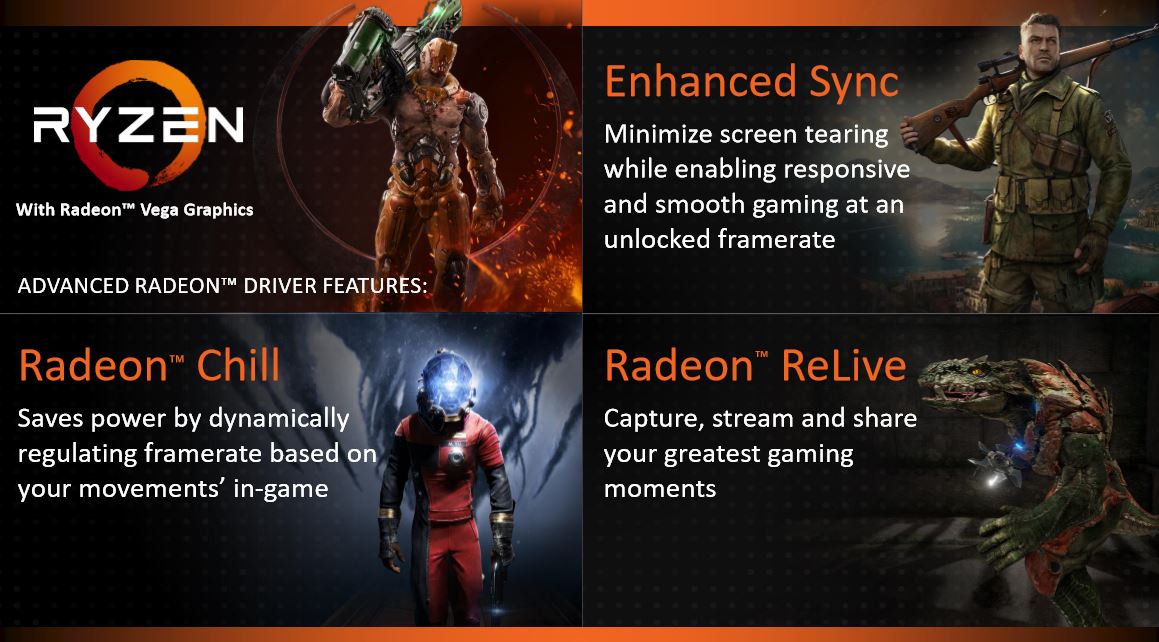
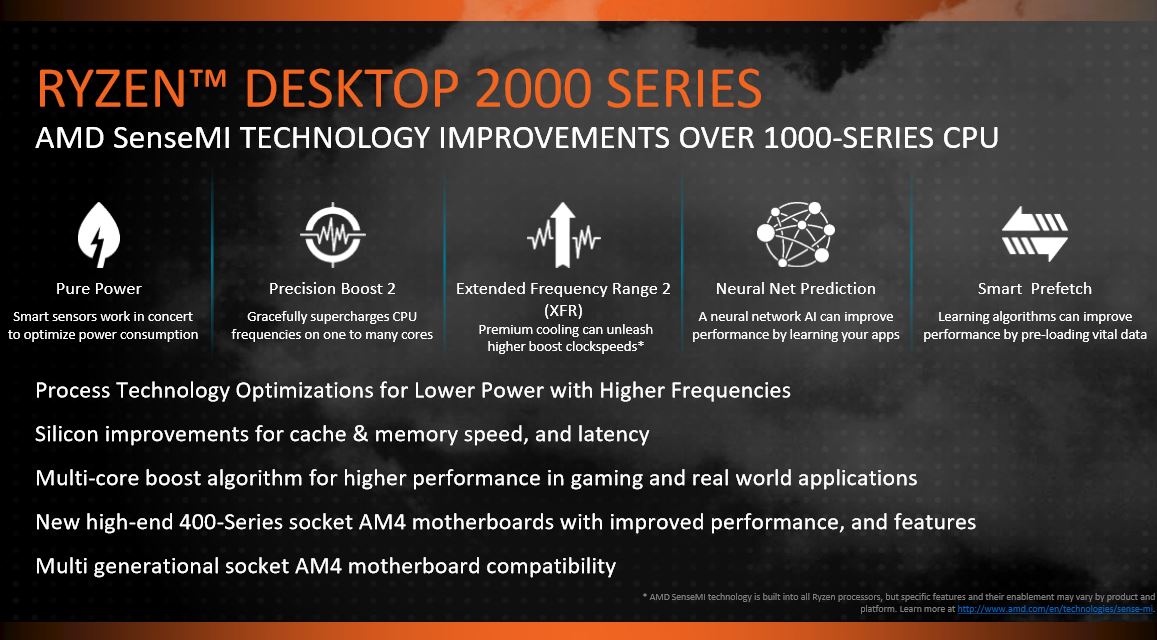
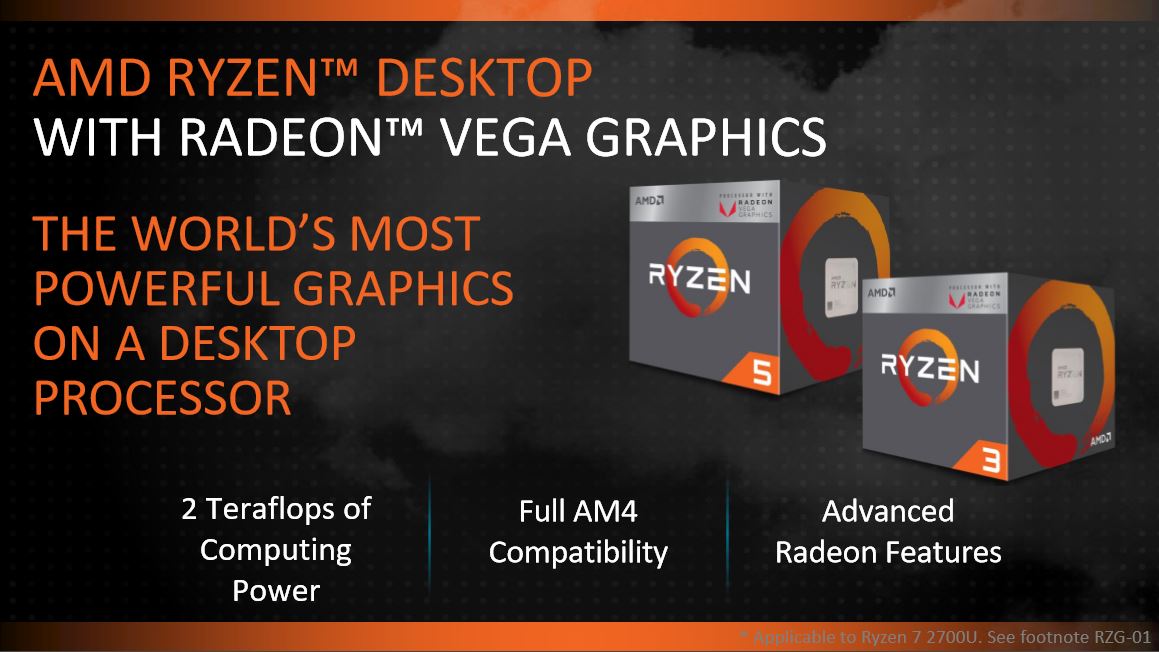
Both of these models slot into the lower end of the Ryzen 5 and Ryzen 3 families. The processors are compatible with either the X470 chipset, which is the second generation of AMD's AM4 platform, or existing 300-Series motherboards. AMD says the $169 Ryzen 5 2400G offers the same performance in 3DMark Time Spy as the comparable $199 Core i5-8400. Moreover, AMD says you would need to pair the Intel Core i5-8400 with an Nvidia GT 1030 to achieve the same level of performance, which would add much more cost into the equation.
The new 2000-Series processors also support the Precision Boost 2 feature we outlined above, while also continuing to leverage AMD's SenseMI suite. The processors feature all of the features we expect from the Vega graphics engine, such as HDR, FreeSync 2, and Radeon Chill, among others.
AMD also provided test results that show the new desktop APUs comparing favorably against Intel's Core i5-8400 and i3-8100. Notably, these processors fall slightly above the price range of Intel's Pentium processors, which is where we long expected AMD to attack with the desktop APUs. In either case, AMD's benchmark results are impressive against Intel's graphics-limited processors. As always, we recommend that you wait until there are third-party reviews. We also included the test notes at the bottom of the article in a click-to-expand format.
X470 Chipset
AMD also announced the new second-generation X470 chipset for the new Zen+ processors. As promised, AMD will continue to support the AM4 platform until 2020. That means that the new Zen+ processors will drop into both 300- and 400-series motherboards, and the first-generation Ryzen processors are also cross-compatible. AMD designed a badge to alert users that some 300-series motherboards will require a BIOS update before you can use a 2000-Series processor. Eventually all the 300-series motherboards will support the new Zen+ processors out of the box.


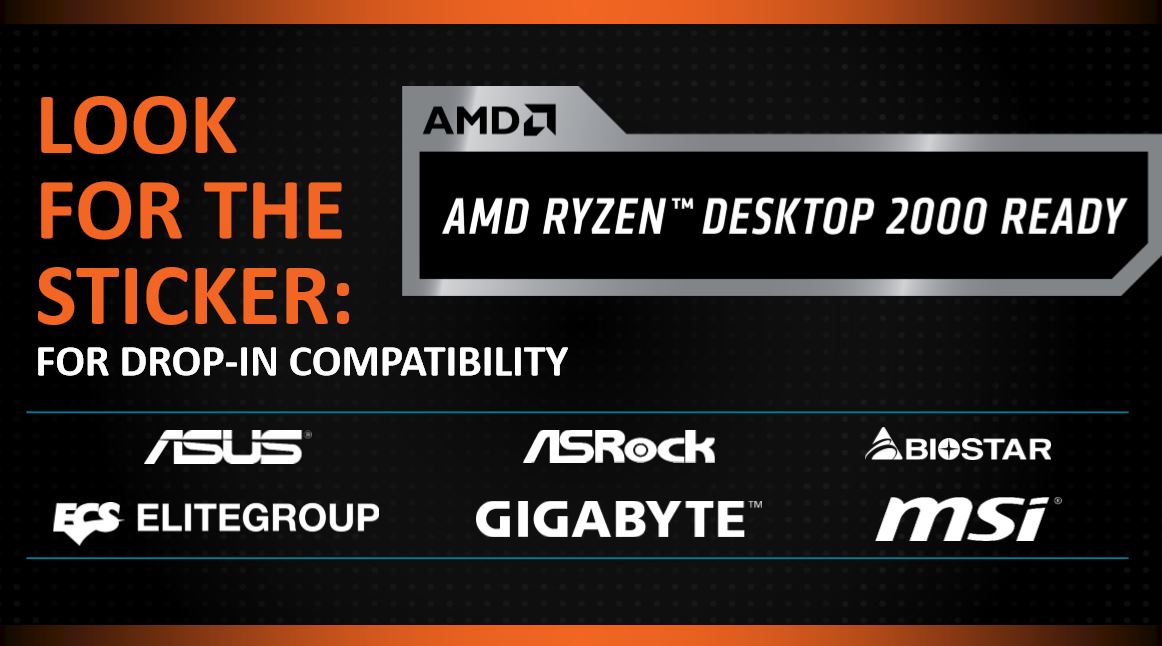
AMD said the chipsets will be less expensive than 300-series boards. The company is working on several improvements, such as lower power consumption, multi-hub USB throughput, improved power delivery, and improvements to the memory layout.
AMD expects the new boards to be available in April 2018, as the new 2000-Series processors, which we've covered here, come to market.
Ryzen Mobile


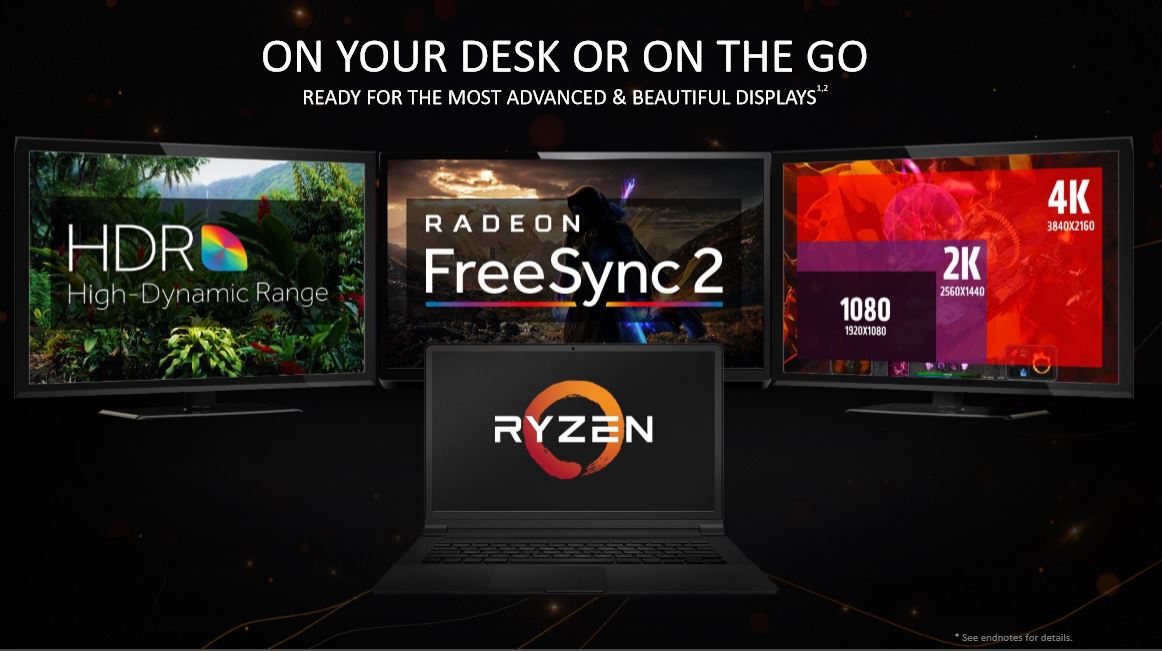


AMD also filled out the lower end of its mobile stack with two new Ryzen Mobile processors. The Ryzen 7 2700U comes with four physical cores and 6 CUs that reach up to 1100 MHz. It boosts to 3.4 GHz. The Ryzen 7 2200U comes with two cores and four threads, also boosts to 3.4 GHz, and features 3 CUs that reach 1000 MHz. We don't have more details yet on these new 15W mobile processors.



AMD has a solid roadmap of process improvements on the horizon and a range of complimentary technologies, like the Infinity Fabric. Intel is undoubtedly late with 10nm, just as custom foundries are finally gaining parity with in-house operations. That situation bodes well for AMD as it ramps to 7nm.

Paul Alcorn is the Editor-in-Chief for Tom's Hardware US. He also writes news and reviews on CPUs, storage, and enterprise hardware.
-
Lucky_SLS " AMD said the chipsets will be less expensive than 300-series boards."Reply
That's great news -
Cryio 7% IPC improvement per generation AND higher clocks, AND lower cost AND lower power usage?Reply
Ryzen will get dramatically better, really fast. -
nitrium Hope these new CPUs pan out. I will be (finally) upgrading my main work PC (a positively ancient i5 760 from 2010 - the longest I've ever used the same CPU) this year, and only care about bang for the buck. If I can get an AMD chip that is faster at lower thread apps/games (most apps/games don't really utilise a lot of threads) than an i5 8600K (my current pick) for the same money, then I have no qualms about grabbing that instead (especially if the mobo's are cheaper too).Reply -
chicofehr Glad i waited. I wanted to get the threadripper. This will bring the 1900 series prices down. I can still eat then. I'll still go hungry but less so LOLReply -
-Fran- Feb 12, then.Reply
I will expect day 1 APU benchies relaxing next to the lake I'll be in, haha.
Don't disappoint me, AMD! My A8-3800 "Llano" is in need for an upgrade.
Cheers! -
neblogai 'We also included the test notes at the bottom of the article in a click-to-expand format'Reply
Is it my browser acting strange, or those notes are missing? -
DragonAsta ONLY Athlon based supposedly were affected by Spectre, do a wee bit of reading first DA_MAZ ^.^Reply
On another note, 400 series will be less expensive, sure, that is AMD intention, does not mean their customers (Asus, MSI etc) pass the savings on, and sure as hell does not mean the resellers (Newegg, Amazon et al) will ensure such either.
I recall the 400 series launch, claim $200 first VR ready graphics card, sure if you were REALLY LUCKY and USA specifically, it is fine if they make a really top notch custom cooler, not so cool if you get some putzes like XFX putting removable fans on there (which they all should have) and wanting an extra ~$100 extra.
Also, show some love to us Canadian folks, often enough, what should be a fair price gets morphed into a ~$30-$70 price increase AND HST/shipping, turns into a not so fair price..free trade my arse ^.^ -
hgchuong Would love to have seen some ultra-low power chips like the ones used in NUCs.Reply
Fingers crossed they'll have something in the near future. -
DA_Maz Reply20574602 said:ONLY Athlon based supposedly were affected by Spectre, do a wee bit of reading first DA_MAZ ^.^
On another note, 400 series will be less expensive, sure, that is AMD intention, does not mean their customers (Asus, MSI etc) pass the savings on, and sure as hell does not mean the resellers (Newegg, Amazon et al) will ensure such either.
I recall the 400 series launch, claim $200 first VR ready graphics card, sure if you were REALLY LUCKY and USA specifically, it is fine if they make a really top notch custom cooler, not so cool if you get some putzes like XFX putting removable fans on there (which they all should have) and wanting an extra ~$100 extra.
Also, show some love to us Canadian folks, often enough, what should be a fair price gets morphed into a ~$30-$70 price increase AND HST/shipping, turns into a not so fair price..free trade my arse ^.^
Thx for your answer.
I read quite a bit about Meltdown/Spectre, but I haven't come accross information that says no AMD processors aren't affected by Spectre except Athlon based chips (and I guess this means Ryzen chips aren't affected by Meltdown/Spectre in the slightest bit?).
I would highly appreciate it, if you could link to source stating this.
regards,
DA_Maz

